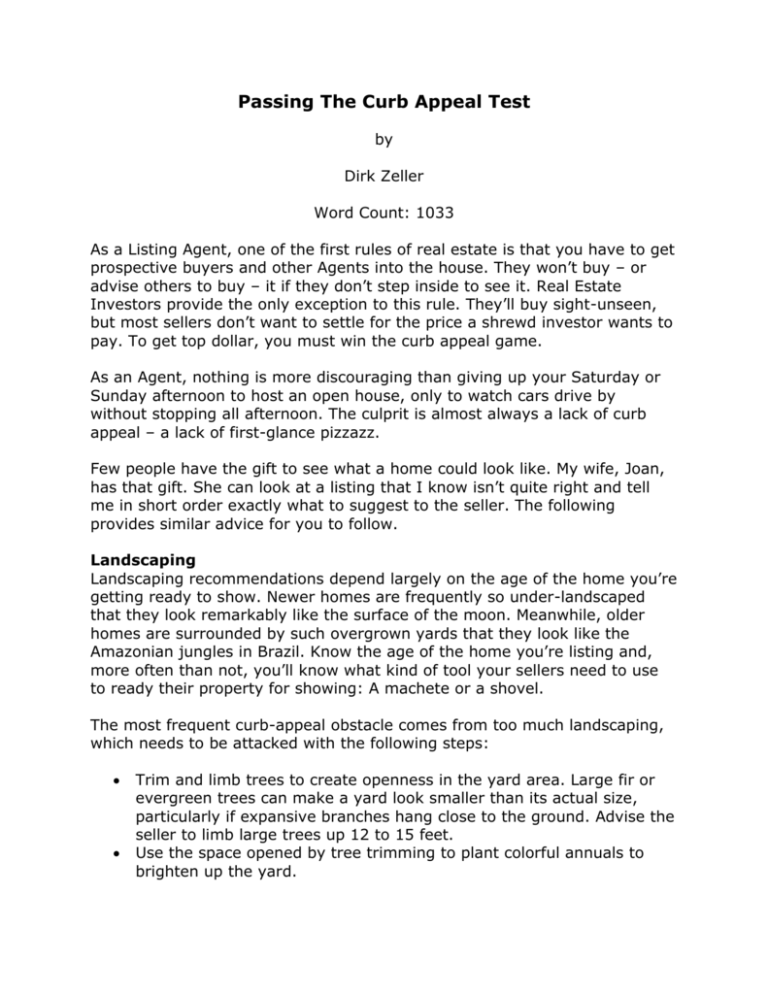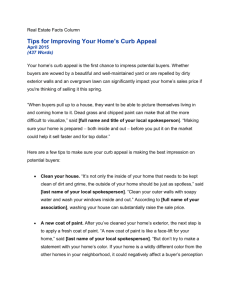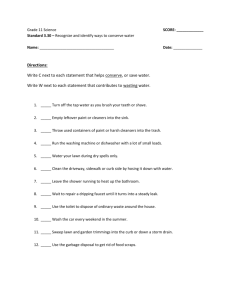
Passing The Curb Appeal Test
by
Dirk Zeller
Word Count: 1033
As a Listing Agent, one of the first rules of real estate is that you have to get
prospective buyers and other Agents into the house. They won’t buy – or
advise others to buy – it if they don’t step inside to see it. Real Estate
Investors provide the only exception to this rule. They’ll buy sight-unseen,
but most sellers don’t want to settle for the price a shrewd investor wants to
pay. To get top dollar, you must win the curb appeal game.
As an Agent, nothing is more discouraging than giving up your Saturday or
Sunday afternoon to host an open house, only to watch cars drive by
without stopping all afternoon. The culprit is almost always a lack of curb
appeal – a lack of first-glance pizzazz.
Few people have the gift to see what a home could look like. My wife, Joan,
has that gift. She can look at a listing that I know isn’t quite right and tell
me in short order exactly what to suggest to the seller. The following
provides similar advice for you to follow.
Landscaping
Landscaping recommendations depend largely on the age of the home you’re
getting ready to show. Newer homes are frequently so under-landscaped
that they look remarkably like the surface of the moon. Meanwhile, older
homes are surrounded by such overgrown yards that they look like the
Amazonian jungles in Brazil. Know the age of the home you’re listing and,
more often than not, you’ll know what kind of tool your sellers need to use
to ready their property for showing: A machete or a shovel.
The most frequent curb-appeal obstacle comes from too much landscaping,
which needs to be attacked with the following steps:
Trim and limb trees to create openness in the yard area. Large fir or
evergreen trees can make a yard look smaller than its actual size,
particularly if expansive branches hang close to the ground. Advise the
seller to limb large trees up 12 to 15 feet.
Use the space opened by tree trimming to plant colorful annuals to
brighten up the yard.
If the seller’s yard features grass, make sure it’s healthy and green.
Recommend a little over-seeding or sod replacement in troubled spots
if necessary to achieve a look that’s more like a golf course than a
motocross course. There is nothing more inviting to kids than a nice
patch of grass where they can run and play, and when kids are happy,
parents are usually happy, too.
Add landscape dimension to otherwise flat lots with plants, berms, or
rocks. Don’t overdo it, but do add a little height and depth to break
what otherwise might look like a dull lot.
Also create dimension through color. Especially if you are presenting a
home in a season other than spring, the landscaping can look pretty
monochromatic. Colorful plants go a long way toward adding visual
interest and strengthening curb appeal.
Exterior paint condition and color
In a split-second, the color and condition of a home’s exterior paint can
either attract or repel a prospective buyer.
Color: Recommend that sellers think long and hard about pastel colors
like robin’s egg blue or pink, or color schemes that resemble the
uniforms of their college or university team. Just as with hard surfaces
on the inside, the exterior of a home for sale should be painted in
classic, muted tones.
The architecture of the home can contribute to the decision regarding
what colors are appropriate for the home. For example, white paint on
a colonial-style home can enhance the property’s visual impression
from the curb, evoking the image of great, stately homes such as the
White House or President Washington’s Mt. Vernon home. The same
white paint on a 1950’s or 1960’s ranch home might result in a house
that looks like a plain little box with no character. The more a home
looks like thousands of other personality-free homes, the lower the
chance that buyers will make a strong offer in hopes of calling it their
own.
Paint Condition: It doesn’t take long for sellers to cross off homes in
need of new paint from their lists, whether the chipped paint is on the
body or trim of the home or on fences or railings.
The worst outcome is a non-stop drive by, but even if a prospective
buyer stops more trouble likely lurks. If the exterior paint condition is
poor and buyers consider the home anyway, you might wish they
hadn’t, and here’s why.
Once buyers notice that paint is peeling, cracking, chipping, or
stripped down to bare wood, they go into high-scrutiny mode and
begin to pick the home apart. Rather than looking for wonderful
things about the home, they fixate on what they think is wrong. They
assume that if something as obvious as the paint is in poor condition,
there must be worse things to discover.
A buyer determined to find faults will succeed. No home can withstand a
microscopic faultfinding inspection.
Even if the home passes the inaugural buyer examination, the sellers aren’t
out of the woods. If the buyer decides to make an offer, almost certainly it
will be accompanied by an extensive repair list and the request that every
minor offense be rectified before the closing. Then a home inspector will
enter the picture, providing a more extensive report and the chance for the
buyer to hit the seller up all over again. All this from a little chipping paint
that could, and should, have been fixed before buyers ever drove by to view
the home in the first place.
Dirk Zeller is an Agent, an Investor, and the President & CEO of Real Estate
Champions. His company trains more than 350,000 Agents worldwide each
year through live events, online training, self-study programs, and
newsletters. He's the widely published author of Your First Year in Real
Estate, Success as a Real Estate Agent for Dummies®, The Champion Real
Estate Agent, Telephone Sales for Dummies®, and over 300 articles in
print. You can get more information by visiting
www.RealEstateChampions.com. © 2008, Dirk Zeller. All rights reserved.
For information contact FrogPond at 800.704.FROG(3764) or email
susie@FrogPond.com; http://www.FrogPond.com

![[Agency] recognizes the hazards of lead](http://s3.studylib.net/store/data/007301017_1-adfa0391c2b089b3fd379ee34c4ce940-300x300.png)






